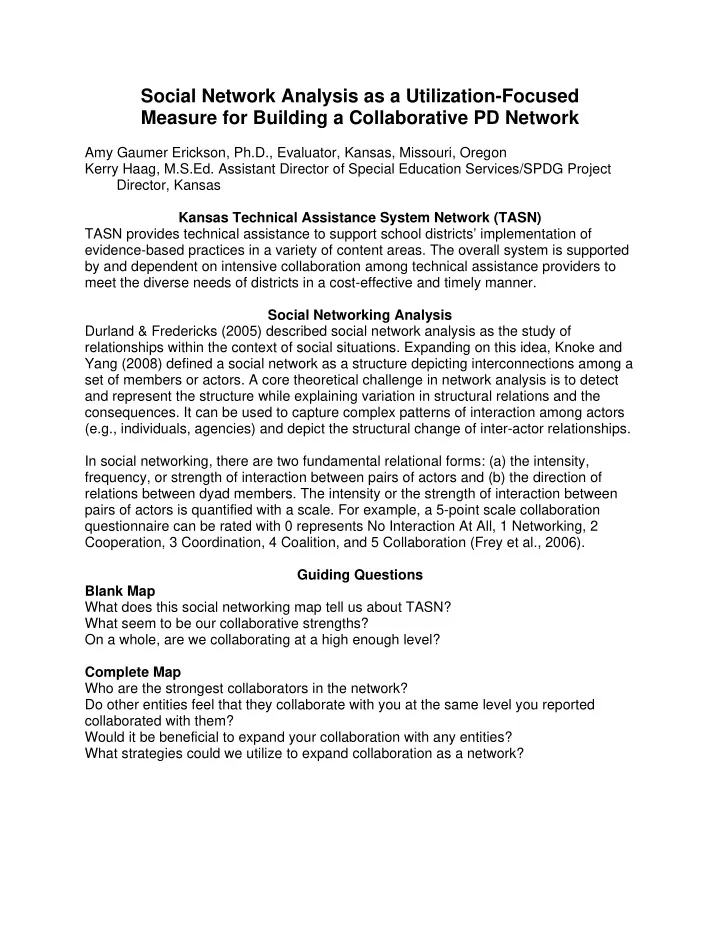

Social Network Analysis as a Utilization-Focused Measure for Building a Collaborative PD Network Amy Gaumer Erickson, Ph.D., Evaluator, Kansas, Missouri, Oregon Kerry Haag, M.S.Ed. Assistant Director of Special Education Services/SPDG Project Director, Kansas Kansas Technical Assistance System Network (TASN) TASN provides technical assistance to support school districts’ implementation of evidence-based practices in a variety of content areas. The overall system is supported by and dependent on intensive collaboration among technical assistance providers to meet the diverse needs of districts in a cost-effective and timely manner. Social Networking Analysis Durland & Fredericks (2005) described social network analysis as the study of relationships within the context of social situations. Expanding on this idea, Knoke and Yang (2008) defined a social network as a structure depicting interconnections among a set of members or actors. A core theoretical challenge in network analysis is to detect and represent the structure while explaining variation in structural relations and the consequences. It can be used to capture complex patterns of interaction among actors (e.g., individuals, agencies) and depict the structural change of inter-actor relationships. In social networking, there are two fundamental relational forms: (a) the intensity, frequency, or strength of interaction between pairs of actors and (b) the direction of relations between dyad members. The intensity or the strength of interaction between pairs of actors is quantified with a scale. For example, a 5-point scale collaboration questionnaire can be rated with 0 represents No Interaction At All, 1 Networking, 2 Cooperation, 3 Coordination, 4 Coalition, and 5 Collaboration (Frey et al., 2006). Guiding Questions Blank Map What does this social networking map tell us about TASN? What seem to be our collaborative strengths? On a whole, are we collaborating at a high enough level? Complete Map Who are the strongest collaborators in the network? Do other entities feel that they collaborate with you at the same level you reported collaborated with them? Would it be beneficial to expand your collaboration with any entities? What strategies could we utilize to expand collaboration as a network?
Levels of Collaboration Scale (Frey et al., 2006) for KSDE TASN Please review these descriptions of different levels of collaboration. On the response section at the bottom of the page, please circle the name of the organization or group with which you are associated. Using the scale provided, please indicate the extent to which you currently interact with each partner. Five Levels of Collaboration and Their Characteristics Networking Cooperation Coordination Coalition Collaboration 1 2 3 4 5 Relationship -Aware of organization Provide information to each -Share information and -Share ideas -Members belong to one Characteristics -Loosely defined roles other resources -Share resources system -Little communication - Somewhat defined roles -Defined roles -Frequent and prioritized -Frequent communication -All decisions are made -Formal communication -Frequent communication communication is characterized by mutual independently -All decisions are made -Some shared decision -All members have a vote trust independently making in decision making -Consensus is reached on all decisions No Partners Networking Cooperation Coordination Coalition Collaboration Interaction Families Together, Inc. 0 1 2 3 4 5 General Supervision & Accurate Data 0 1 2 3 4 5 0 1 2 3 4 5 Infinitec/InfiniTEXT Kansas Educational Employment (KEEB) 0 1 2 3 4 5 Board/eMentoring for Student Success (eMSS) 0 1 2 3 4 5 Kansas Inservice Training System (KITS) Kansas Autism Project (KISN) 0 1 2 3 4 5 Kansas MTSS Project 0 1 2 3 4 5 0 1 2 3 4 5 Kansas Parent Information Resource Center (PIRC) 0 1 2 3 4 5 Kansas Secondary Connections KSDE Special Education Services (SES) 0 1 2 3 4 5 Kansas Instructional Resource Center for the Blind and 0 1 2 3 4 5 Visually Impaired (KIRC) Low Incidence Consortium 0 1 2 3 4 5 0 1 2 3 4 5 TASN Coordination and Evaluation 0 1 2 3 4 5 All-State Low Incidence Virtual Endorsement (ALIVE) Project Success & Co-Teaching 0 1 2 3 4 5 TASN Tertiary Behavior Supports 0 1 2 3 4 5
General Supervision Infinitec / and InfiniTEXT Accurate Data Families Together Inc. KEEB / eMSS TASN Tertiary Behavior Supports KITS Project Success KISN Project ALIVE TASN Kansas MTSS Coordination & Project Evaluation Project Low Incidence KPIRC Consortium -- Key -- Kansas KIRC / Level 0 None No line Secondary Level 1 Networking No line TVI COMS Connections KSDE Level 2 Cooperation SES Level 3 Coordination Level 4 Coalition Level 5 Collaboration
Recommend
More recommend